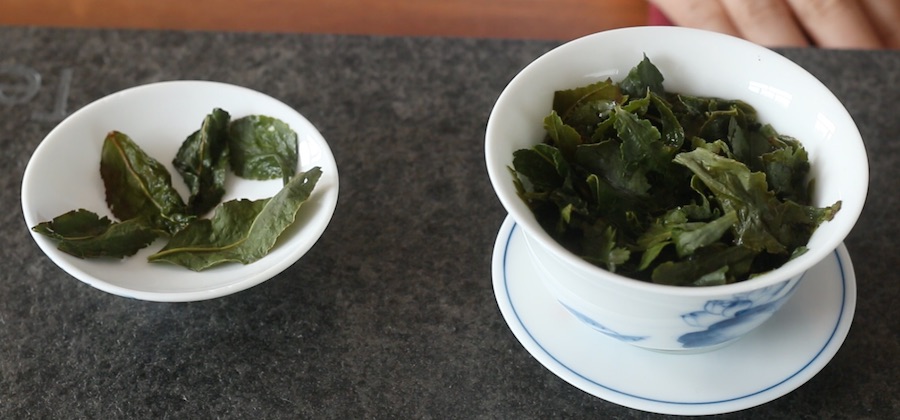The title of this post might sound confusing to some. After all 'Tie Guan Yin' is a type of oolong tea, so why should we compare this to a whole category of green tea? Well, there are good reasons for it. For beginning tea explorers, the distinction between lightly oxidised oolongs and green tea can sometimes be confusing.
Tie Guan Yin vs Green Tea: The Level of Oxidation
All leaf teas are made from different cultivars of the Camellia Sinenses tea plant. The categorization of individual teas in different types is based on the processing method applied. Due to this, the resulting teas have undergone different levels of oxidation.
The processing of green tea is relatively simple compared to that of a Tie Guan Yin (or Ti Kuan Yin). Green tea is plucked, dried in open air, and then roasted in a pan to directly stop the oxidation of the leaves. Due to this, green teas are minimally processed.
Tie Guan Yin, however, has more steps when it comes to the production. The leaves are allowed more time to wither and undergo more intensive steps such as tossing and rolling.
Tie Guan Yin vs Green Tea: Appearance
Fresh green teas generally look greener compared to the dark green looks of Tie Guan Yin. You'll also easily notice that the latter is tightly rolled, while green teas are generally loose. This becomes especially clear when you try to store these teas in a jar. The same jar might store 500g of Tie Guan Yin, while it perhaps only fits 150g of Huang Shan Mao Feng green tea.
When you steep a tie guan yin, you can see that the edges of the leaves have a yellow/orange colour. That's due to the rolling of the leaves. See the image below:

It's however less oxidised compared to other oolongs such as 'Da Hong Pao', which has much darker leaves. Thus, it makes sense for us to compare Tie Guan Yin in isolation to green tea. Note that darker Tie Guan Yin teas also exist, though they are less common.
Taste Differences
When you steep both teas, you'll see that a good green tea will generally consist of younger leaves and/or buds. On the other hand, a Tie Guan Yin often consists of larger leaves. This doesn't mean that it's bad quality. Green tea is generally produced from smaller bushes. Leaves from these bushes are especially suitable for the very light processing method of green tea. It results in subtle flavors of soy beans, veggies, or roasted nuts that green tea lovers appreciate.
Tie Guan Yin on the other hand requires somewhat larger leaves that can handle the more intensive production method. Processing such leaves the 'green tea way' will result in a more bitter brew, but by letting them wither and oxidize more, the final taste is very soft, mellow, smooth and slightly more savory. The liquor texture is also somewhat more thick. At last, tea masters apply slight differences in processing to produce unique flowery aromas.
Brewing
When it comes to preparing the teas, a temperature of 75 to 85 C needs to be applied to green teas, depending on how delicate they are. It could be made in a gaiwan or brewed in a casual way in a glass.
Tie Guan Yin however definitely should be made with as hot as possible water. It should be prepared the kungfu way in a gaiwan or even better small teapot that isolates heat well. Otherwise, the tightly rolled leaves won't unfurl easily, and you won't be able to draw out the more layered flavours. See the video below for a complete tutorial on brewing Tie Guan Yin:
Be careful with how much tea you put in the gaiwan, as they can unfurl and completely fill the gaiwan:
Health Benefits
Don't worry to much in the difference in health benefits. Yes, green tea is less processed so it holds more anti-oxidants. Yet, the differences aren't that big. They're still teas made from closely related cultivars of the Camellia Sinenses tea plants. And the processing of Tie Guan Yin is still relatively light compared to darker oolongs.
What's important is that you enjoy the teas, so that you can make them part of your daily rituals. The calming effects and mental effects can only be enjoyed when you truly love the teas you drink.
At last, you don't need to choose and stick to one type of tea, you should instead, enjoy the diversity that the world of tea has to offer. And if you do so, you might as well find out what teas are better to drink during different parts of the day or across different seasons. Go for example for green teas during hot summers, while you keep your Tie Guan Yin for mild Spring and Autumn weathers. Find out more in this post: Best time to drink tea during day & season